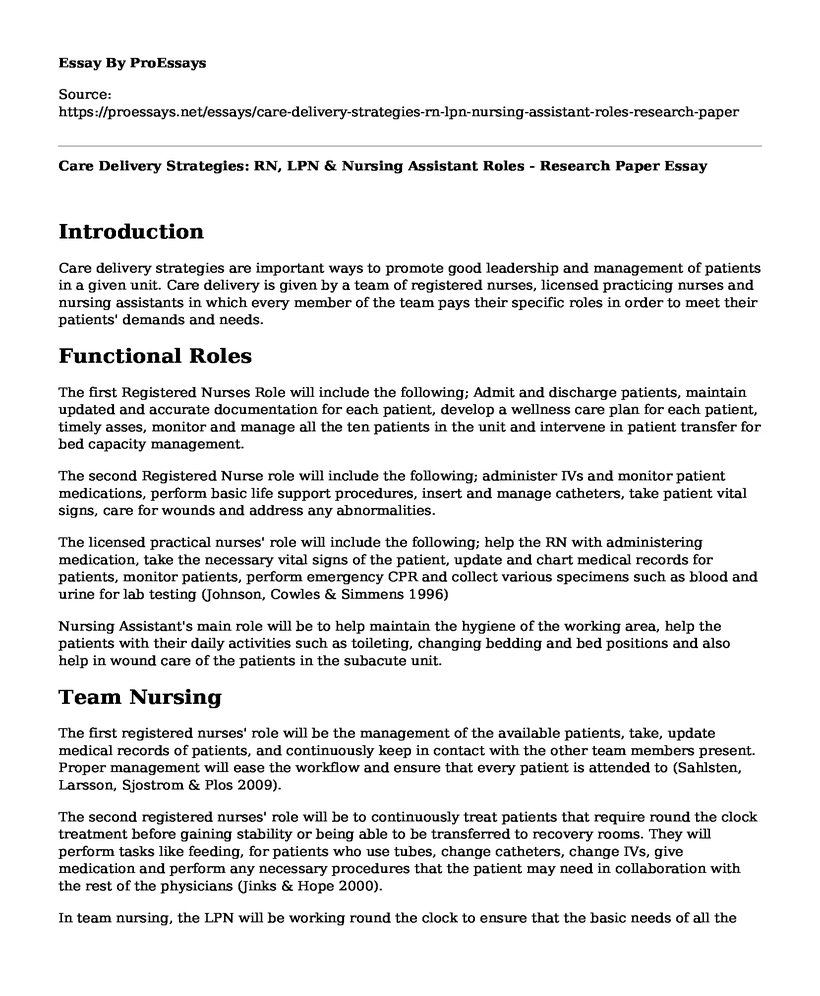Introduction
Care delivery strategies are important ways to promote good leadership and management of patients in a given unit. Care delivery is given by a team of registered nurses, licensed practicing nurses and nursing assistants in which every member of the team pays their specific roles in order to meet their patients' demands and needs.
Functional Roles
The first Registered Nurses Role will include the following; Admit and discharge patients, maintain updated and accurate documentation for each patient, develop a wellness care plan for each patient, timely asses, monitor and manage all the ten patients in the unit and intervene in patient transfer for bed capacity management.
The second Registered Nurse role will include the following; administer IVs and monitor patient medications, perform basic life support procedures, insert and manage catheters, take patient vital signs, care for wounds and address any abnormalities.
The licensed practical nurses' role will include the following; help the RN with administering medication, take the necessary vital signs of the patient, update and chart medical records for patients, monitor patients, perform emergency CPR and collect various specimens such as blood and urine for lab testing (Johnson, Cowles & Simmens 1996)
Nursing Assistant's main role will be to help maintain the hygiene of the working area, help the patients with their daily activities such as toileting, changing bedding and bed positions and also help in wound care of the patients in the subacute unit.
Team Nursing
The first registered nurses' role will be the management of the available patients, take, update medical records of patients, and continuously keep in contact with the other team members present. Proper management will ease the workflow and ensure that every patient is attended to (Sahlsten, Larsson, Sjostrom & Plos 2009).
The second registered nurses' role will be to continuously treat patients that require round the clock treatment before gaining stability or being able to be transferred to recovery rooms. They will perform tasks like feeding, for patients who use tubes, change catheters, change IVs, give medication and perform any necessary procedures that the patient may need in collaboration with the rest of the physicians (Jinks & Hope 2000).
In team nursing, the LPN will be working round the clock to ensure that the basic needs of all the patients are met. The LPN will also work closely with the registered nurse inpatient monitoring and report any changes, complications or any developments of the patient to the RN or attending physicians. Depending on the bed capacity and amount of work, the LPN will clean and dress the wound, administer medications, check for vital signs such as blood pressure and still help the registered nurses in changing IVs.
The Nursing Assistant will continue to check for and maintain hygiene in case of a procedure. A nursing assistant will work round the clock to ensure patient hourly toileting routines in place, bed covers are changed in time and ensure that patients are well placed on their beds by continuously going around to monitor any slight changes.
Primary Nursing
The RN plays a major role in primary nursing care. The first registered role in primary nursing in this given scenario will be to work directly with the attending physicians and the whole team as partners to ensure that the patient care standards are observed to promote a timely recovery. The registered nurse will ensure timely screenings of patients, promote early detection of other symptoms or chronic illnesses, help in disease management and patient care and give access to the team for any item required for given procedures (Bodenheimer & Bauer 2016).
References
Bodenheimer, T., & Bauer, L. (2016). Rethinking the primary care workforce-an expanded role for nurses. New England journal of medicine, 375(11), 1015-1017. doi: 10.1056/NEJMp1606869.
Jinks, A. M., & Hope, P. (2000). What do nurses do? An observational survey of the activities of nurses in acute surgical and rehabilitation wards. Journal of Nursing management, 8(5), 273-279. DOI: 10.1046/j.1365-2834.2000.00182.x
Johnson, J., Cowles, C. M., & Simmens, S. J. (1996). Quality of care and nursing staff in nursing homes. Nursing staff in hospitals and nursing homes: Is it adequate, 426-452. https://www.ncbi.nlm.nih.gov/pubmed/12037152
Sahlsten, M. J., Larsson, I. E., Sjostrom, B., & Plos, K. A. (2009). Nurse strategies for optimising patient participation in nursing care. Scandinavian journal of caring sciences, 23(3), 490-497. doi: 10.1111/j.1471-6712.2008.00649. x. Epub 2009 Jun 23
Cite this page
Care Delivery Strategies: RN, LPN & Nursing Assistant Roles - Research Paper. (2023, Jan 30). Retrieved from https://proessays.net/essays/care-delivery-strategies-rn-lpn-nursing-assistant-roles-research-paper
If you are the original author of this essay and no longer wish to have it published on the ProEssays website, please click below to request its removal:
- Media Violence Impact on Real Life
- Essay About Irish Immigration to America
- Nursing Shortage: Presenting the Problem Paper Example
- Fetal Abortion Christian View Essay Example
- Essay Sample on Texas on the Brink: Economic Policies to Reduce Poverty
- Essay Example on Natural & Human-Made Disasters: Causes & Effects
- Alcohol, Drug Abuse, Crime: A Closer Look - Essay Sample







